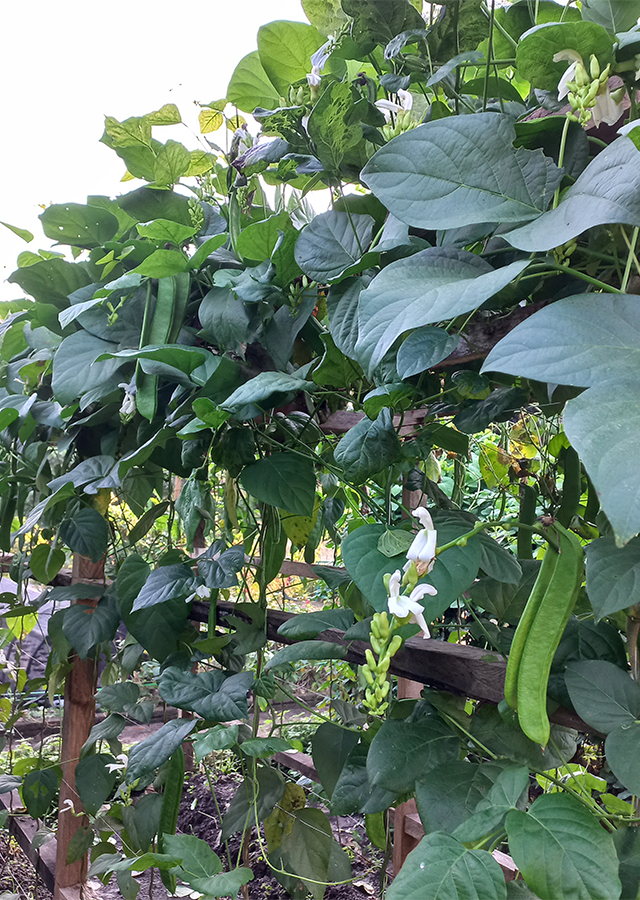Traditional Herbs from Canavalia ensiformis
boils
- Prepare white sword bean leaves, wash them thoroughly.
- Crush them until they become a paste.
- Apply the leaf paste on the boils.
strengthen_kidneys
- Take the seeds\u00a0of white sword beans, wash them until clean.
- Boil the beans until soft.
- Eat to strengthen the kidneys.
What is Canavalia ensiformis Looks like??



Parts of Canavalia ensiformis that could be used
- Young Pods
- Leaves
- Seeds
Canavalia ensiformis Distribution
White sword beans are native to South America and Central America, and have been introduced to tropical and subtropical regions throughout the world. This plant has a long history of cultivation, where white sword beans have been grown in Mexico since around 3,000 BC and widely cultivated in the southern United States since prehistoric times, and are now cultivated throughout the tropics. This plant has various benefits, including being used as a food crop, animal feed, green manure, and a cover crop to control erosion. Traditionally the young pods are used as a vegetable, while the seeds can be processed into tempeh or bean sprouts. Sometimes, the roasted and ground seeds can also be used as a coffee substitute. Sword koro seeds cannot be eaten directly because they will cause dizziness caused by the presence of toxic compounds, but through the heating or boiling process they can eliminate the toxins in them. This plant is commonly consumed in Southeast Asia and Japan. Based on study results, this plant is known to contain concanavalin A which can be used as an antiviral and immunomodulatory molecule for cancer therapy. Heat-treated seeds and pods are also used as ingredients in traditional medicine in Indonesia and China. In Nigeria, sword bean seeds are used as an antibiotic and antiseptic.Agroecology of Canavalia ensiformis
White sword beans can be found fertile in temperate to tropical climates at altitudes up to 1,500 m above sea level. It grows best at temperatures between 13-27 °C, with optimal annual rainfall between 800-2,000 mm, but can tolerate 600-4,300 mm. Prefers areas in full sun but tolerates moderate shade. Able to grow and adapt to a variety of soil conditions under harsh conditions, even in nutrient-deficient soils, highly leached, acidic soils, and resistant to drought, but does not grow well in soils that are too wet. Its growth also requires soil conditions with a soil acidity (pH) in the range of 5-6, but tolerates 4.3-8.
Morphology of Canavalia ensiformis
- Roots have a deep root system, have nodules on the roots to fix nitrogen.
- Stems are cylindrical, puberulent, glabrous, with hollow pith, short and large, become somewhat woody with age.
- Leaves alternate or scattered, colored green, thick, compound with three leaflets (trifoliolate). Leaf blades are broadly ovate or broadly elliptical, blunt or round-tapered leaf tips, blunt base, asymmetrical on the leaflets. lateral, leaf margins flat, rarely hairy on both surfaces.
- Flowers pale purple, sometimes white, found on axillary racemes with swollen nodes, clusters of 1-3 flowers on swollen nodes along the rachis. Petals are green. cone-shaped, 5-lobed, rarely pubescent. Crown is standard round.
- Fruit pods, large, long, linear, and flat like a sword, slightly curved towards the apex, each pod contains 8-20 seeds.
- Shaped seeds ellipse, up to 3 cm long, white or cream colored, hilum less than half the length of the seed, hilum brown.
Cultivation of Canavalia ensiformis
- Propagation is carried out generatively with seeds.
- Planting seeds directly in the field without a seedbed with 2 seeds per hole.
- The planting distance that can be used is 40 cm x 50 cm or 40 cm x 75 cm.
- Green pods can be harvested after 80-120 days, and seeds mature after 180 - 300 days after planting.
Canavalia ensiformis, more details :
Chemical Content of Canavalia ensiformisLectins (concanavalin A and B), tannins, trigonelline, canavanine.
Benefits of Canavalia ensiformis
Immunomodulator for cancer therapy, treating ulcers, strengthening the kidneys. Has activity as an antibiotic and antiseptic.
Simplisia of Canavalia ensiformis
- Prepare white flower sword bean seeds, wash thoroughly with running water then drain.
- Dry in the sun or in an oven temperature\u00a040 \u00b0C\u00a0 until the water content\u00a010%.
- Choose using a blender until it becomes sift powder with a 60 mesh sieve.
- Store in a clean and airtight place.
Another Facts for Canavalia ensiformis :
Synonym of Canavalia ensiformisDolichos acinaciformis Jacq., Dolichos ensiformis L., Phaseolus virosus Bojer
Habitus of Canavalia ensiformis
Bush. Climbing or semi-climbing shrub, annual, up to 50-200 cm high, but can reach a length of 10 m when climbing
Habitat of Canavalia ensiformis
- Forest
- Bushland
- Land
No comments:
Post a Comment